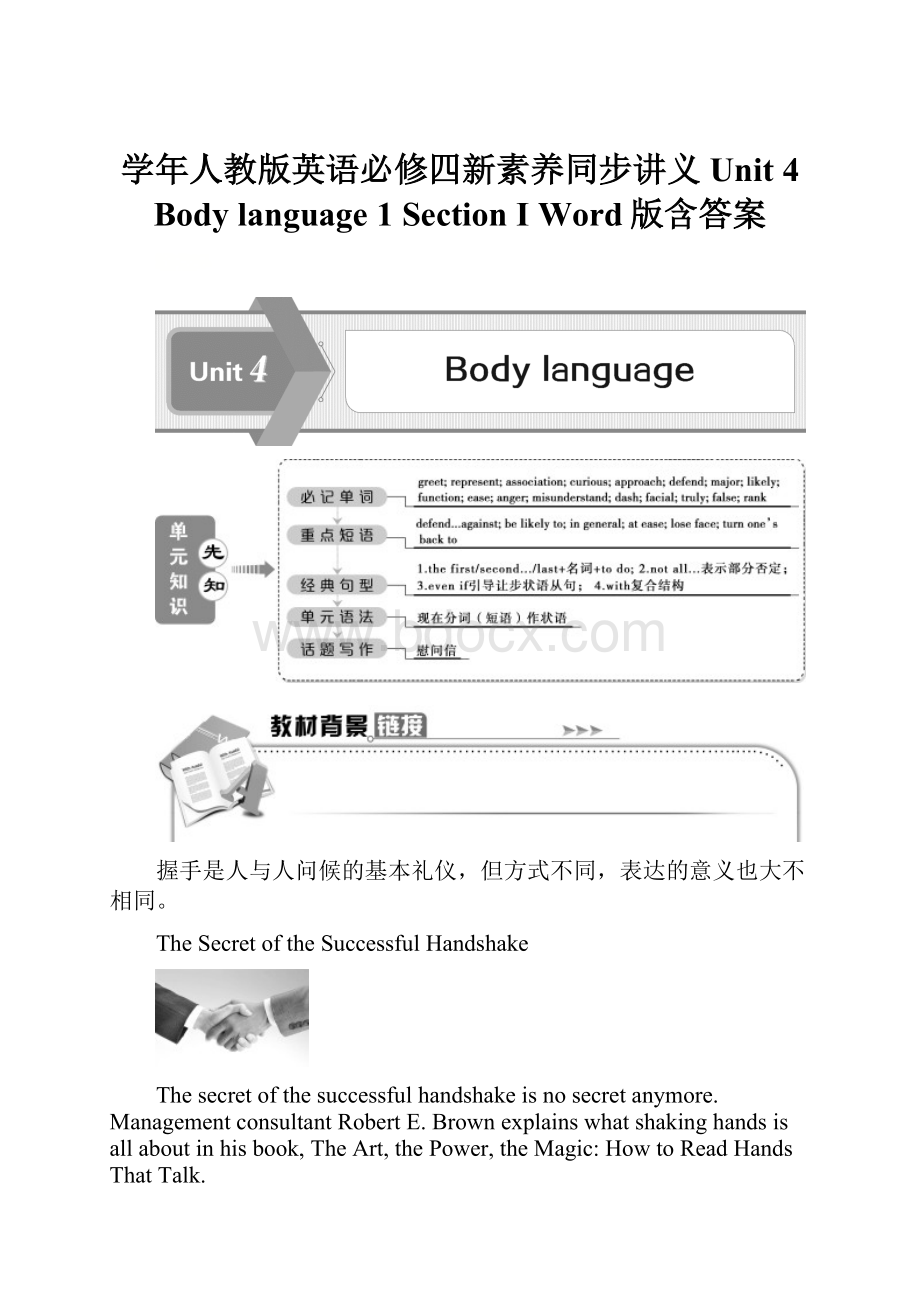学年人教版英语必修四新素养同步讲义Unit 4 Body language 1 Section Ⅰ Word版含答案.docx
《学年人教版英语必修四新素养同步讲义Unit 4 Body language 1 Section Ⅰ Word版含答案.docx》由会员分享,可在线阅读,更多相关《学年人教版英语必修四新素养同步讲义Unit 4 Body language 1 Section Ⅰ Word版含答案.docx(20页珍藏版)》请在冰豆网上搜索。

学年人教版英语必修四新素养同步讲义Unit4Bodylanguage1SectionⅠWord版含答案
握手是人与人问候的基本礼仪,但方式不同,表达的意义也大不相同。
TheSecretoftheSuccessfulHandshake
Thesecretofthesuccessfulhandshakeisnosecretanymore.ManagementconsultantRobertE.Brownexplainswhatshakinghandsisallaboutinhisbook,TheArt,thePower,theMagic:
HowtoReadHandsThatTalk.
Forexample,todothe“AllAmericanHandshake”,youhavetolookintoanotherperson’seyes,holdhisorherwholehand,twoorthreetimes.AccordingtoBrown,thisisthehandshakeofagoodlistenerandtrustworthyperson.
Politiciansandsalespeopleoftenusethe“TwoHandedHandshake”becauseit’sextrafriendly.Theyputtheirlefthandontheotherperson’sarmorshoulderastheyshakehands.Thiscanfeeltoofriendlytosomepeople,soit’sbesttouseitwithgoodfriends.
Watchoutforpeoplewithhandshakesthatpullyourfingers,ortwist(扭转)yourhand.Ifyougetoneofthesehandshakes,thepersonistryingtointimidate(恐吓)you.
Twomoreuncomfortablehandshakesarethe“PalmPinch”andthe“DeadFish”.APalmPinchershakesyourhandwithonlyafewfingers.IntheDeadFishhandshake,theperson’shandslidesoutofthehandshake.It’spossiblethatthepeoplewiththesehandshakesareembarrassed(尴尬的)orshy.
Shakinghandsisanimportantpartofbodylanguage.Itcanidentifysomeoneastruthful,friendly,powerful,ornervous.It’shardtobesuccessfulwithoutknowingaboutagoodhandshakesuchastheAllAmerican.Ifthisisn’tyournaturalhandshake,don’tworry.MrBrownsaysthatyoucanchangeyourhandshakewithlotsofpractice.So,goonoutthereandstartshakinghands.Justthinkofallthepeopleyoucanmeet!
SectionⅠ WarmingUp&Reading—Comprehending
重点单词
写作词汇
1.dormitoryn.宿舍
2.canteenn.食堂
3.approachvt.&vi.接近;靠近;走近
n.接近;方法;途径
4.cheekn.面颊
5.majoradj.主要的
6.adultn.成人;成年人
adj.成人的;成熟的
7.dashvi.猛冲;突进
8.flight__n.飞行;航班
拓展词汇
9.likelyadj.可能的→unlikelyadj.不可能的
10.statementn.陈述;说明→statev.陈述;说明
11.greetvi.&vt.迎接;问候→greetingn.迎接;问候;招呼
12.representvt.代表;象征→representationn.代表,代表团;代理→representativeadj.代表性的n.代表,代理人
13.associationn.社团;联系;联想→associatev.把……联系起来
14.curiousadj.好奇的→curiouslyadv.好奇地→curiosityn.好奇心
15.defendvt.保护;保卫→defencen.防御;保卫
16.misunderstandvt.误解;误会→misunderstandingn.误解;误会
阅读词汇
17.simplyadv.简单地;只
18.Muslimn.&adj.穆斯林(的);__伊斯兰教信徒(的)
19.posturen.姿势;体态
20.crossroadsn.十字路口
重点短语
1.put__up举起;抬起
2.in__defence保卫;防御
3.kiss__sb.on__the__cheek亲吻某人的脸
4.be__likely__to很可能……;有希望……
5.in__general总的来说;通常
6.defend...against防御;保卫……以免受
重点句型
1.thefirst/second/.../last+名词+todo...:
The__first__person__to__arrive(第一个到达的人)wasTonyGarciafromColombia,closelyfollowedbyJuliaSmithfromBritain.
2.状语从句的省略:
Shesteppedbackappearingsurprisedandputupherhands,as__if__in__defence(好像是在自卫).
3.notall...表示部分否定:
Not__all__cultures(并不是所有文化)greeteachotherthesameway,noraretheycomfortableinthesamewaywithtouchingordistancebetweenpeople.
Fast�reading
Skimthetextanddothefollowingexercises.
1.Whatdoesthetextmainlytalkabout?
A.Communication.B.Spokenlanguage.
C.Bodylanguage.D.Differentcultures.
答案:
C
2.Matchthemainideaofeachparagraph.
Para.1 A.Tosuggeststudyinginternationalcustoms.
Paras.2-3B.TomeettheinternationalstudentsattheCapitalInternationalAirport.
Para.4C.Tointroducethestudentstoeachotherandexplaintheirdifferentwaysofgreeting.
Para.5D.Toexplaindifferentcultural“bodylanguage”insomecountries.
答案:
BCDA
Careful�reading
Readthetextcarefullyandchoosethebestanswer.
1.Inwhichofthefollowingcountriesdopeoplegreeteachotherinthesameway?
A.ColombiaandBritain.
B.SpainandItaly.
C.FranceandJordan.
D.ChinaandJapan.
2.Howdoesthetextdevelop?
A.Bygivingexamples.B.Bygivingdata.
C.Bygivingdefinition.D.Bymakingcomparisons.
3.What’sthepurposeofthesecondparagraph?
A.Togiveexamplesofmistakestheinternationalstudentsmake.
B.Togiveexamplesofculturaldifferencesinbodylanguage.
C.Toshowhowsurprisedwearebytheirdifferentbehavior.
D.Toshowhowimportantbodylanguageis.
4.Whatcanwelearnfromthepassage?
A.Nevertoooldtolearn.
B.WheninRome,doastheRomansdo.
C.Foureyesseemorethantwo.
D.Everycountryhasitsowncustoms.
答案:
1-4.BABB
Study�reading
Analyzethefollowingdifficultsentencesinthetext.
1.Theyshookhandsandthenkissedeachothertwiceoneachcheek,sincethatistheFrenchcustomwhenadultsmeetpeopletheyknow.
本句是一个复合句。
句子的主语是They,since引导的是原因状语从句,在从句中when引导的是时间状语从句。
[翻译] 两个人握了握手,并且在对方的面颊上亲吻了两下。
因为法国成年人见到他们认识的人时通常就是这么做的。
2.Inthesamewaythatpeoplecommunicatewithspokenlanguage,theyalsoexpresstheirfeelingsusingunspoken“language”throughphysicaldistance,actionsorposture.
本句是一个复合句。
Inthesamewaythat...是句子的状语,way是先行词,关系代词that引导的是定语从句。
句子的主语是they;usingunspoken“language”throughphysicaldistance,actionsorposture是现在分词作伴随状语。
[翻译] 如同用口头语言交流一样,人们还使用无声的语言——身体间的距离、动作或姿势,来表达他们的情感。
3.Mostpeoplearoundtheworldnowgreeteachotherbyshakinghands,butsomeculturesuseothergreetingsaswell,suchastheJapanese,whoprefertobow.
本句是一个并列句,并列连词but连接两个分句。
在第二个分句中,Japanese是先行词,who引导的是非限制性定语从句。
[翻译] 现在世界上多数人见面时握手相互问候,但有些文化(背景的人)会采取另外一些寒暄的方式。
比方说,日本人就更愿意鞠躬。
①represent[ˌreprI'zent]vt.代表;象征
②association[əˌsəʊsI'eIʃn]n.社团;联系;联想
③dormitory['dɔːmItrI]n.宿舍
④canteen[kæn'tiːn]n.食堂
⑤flight[flaIt]n.飞行;航班
⑥curiously['kjʊərIəslI]adv.好奇地
curious['kjʊərIəs]adj.好奇的
curiosity[ˌkjʊərI'ɒsItI]n.好奇心
⑦greet[ɡriːt]vi.&vt.迎接;问候;和(某人)打招呼(或问好)
⑧approach[ə'prəʊtʃ]vt.&vi.接近;靠近;走近n.接近;方法;途径
⑨kisssb.onthecheek亲吻某人的脸颊
cheek[tʃiːk]n.面颊
⑩indefence保卫;防御
defence[dI'fens]n.防御;保卫
defend[dI'fend]vt.保护;保卫
defend...against防御;保卫……以免受
⑪major['meIdʒə]adj.主要的
⑫misunderstandingn.误解;误会
misunderstand[ˌmIsʌndə'stænd]vt.误解;误会
⑬reachone’shandouttosb.向某人伸出手
⑭bow[baʊ]v.鞠躬
⑮dash[dæʃ]vi.猛冲;突进
⑯adult['ædʌlt;USə'dʌlt]
n.成人;成年人adj.成人的;成熟的
⑰onthecontrary与此相反,恰恰相反
contrarytosth.与某事相反
⑱simply['sImplI]adv.简单地;只
⑲gettodosth.逐渐做某事
get之后的动词不定式多为表示认知过程或心理变化的动词,如gettoknow,gettounderstand,gettorealize,gettoadmit等。
⑳spoken['spəʊkən]adj.口语的,口头的
posture['pɒstʃə]n.姿势
belikelyto很可能……;有希望……
likely['laIklI]adj.可能的
aswell此处意为“也,又”,相当于副词too,多置于肯定句的句末。
prefer[prI'fɜː(r)]v.更喜欢
prefertodosth.更喜欢做某事
ingeneral(=generallyspeaking)总的来说;通常(写文章或说话时作总结用的插入语)
though在此处为副词,意为“然而”。
crossroads['krɒsrəʊdz]n.十字路口
atthe/acrossroads(人生或发展)处于关键时刻,在紧要关头
【核心素养链接】
在面对面的沟通中,人们大部分的信息交流是通过无声的身体语言实现的。
身体语言,也称肢体语言,是指非词语性的身体符号,包括目光与面部表情、身体运动与触摸、身体姿势与外表、身体之间的空间距离等。
通过身体语言实现的沟通,称作身体语言沟通。
身体语言在人际沟通中有着口头语言所不能替代的作用。
因此,要了解他人,我们就要善于观察对方的身体语言;而在沟通的时候,要善于利用自己的身体语言,以便于更好地表达自己。
COMMUNICATION:
NOPROBLEM?
Yesterday,anotherstudentandI,representing①ouruniversity’sstudentassociation②,wenttotheCapitalInternationalAirporttomeetthisyear’sinternationalstudents.TheywerecomingtostudyatBeijingUniversity.Wewouldtakethemfirsttotheirdormitories③andthentothestudentcanteen④.Afterhalfanhourofwaitingfortheirflight⑤toarrive,Isawseveralyoungpeopleenterthewaitingarealookingaroundcuriously⑥.Istoodforaminutewatchingthemandthenwenttogreet⑦them.
◆现在分词短语representingouruniversity’sstudentassociation作定语,前后有逗号隔开,相当于一个非限制性定语从句。
◆现在分词短语lookingaroundcuriously作伴随状语。
◆现在分词短语watchingthem作伴随状语。
ThefirstpersontoarrivewasTonyGarciafromColombia,closelyfollowedbyJuliaSmithfromBritain.AfterImetthemandthenintroducedthemtoeachother,Iwasverysurprised.Tonyapproached⑧Julia,touchedhershoulderandkissedheronthecheek⑨!
Shesteppedbackappearingsurprisedandputupherhands,asifindefence
.Iguessedthattherewasprobablyamajor⑪misunderstanding⑫.ThenAkiraNagatafromJapancameinsmiling,togetherwithGeorgeCookfromCanada.Astheywereintroduced,Georgereachedhishandoutto⑬theJapanesestudent.Justatthatmoment,however,Akirabowed⑭sohisnosetouchedGeorge’smovinghand.Theybothapologized—anotherculturalmistake!
◆本句中closelyfollowedby...是过去分词短语作状语。
Thefirstpersontoarrive意思是“第一个到达的人”,不定式toarrive作后置定语,修饰person。
Thefirstperson与arrive之间是逻辑上的主谓关系。
◆现在分词短语appearingsurprised作伴随状语;asifindefence是asifshewasindefence的省略。
AhmedAziz,anotherinternationalstudent,wasfromJordan.Whenwemetyesterday,hemovedveryclosetomeasIintroducedmyself.Imovedbackabit,buthecameclosertoaskaquestionandthenshookmyhand.WhenDarleneCoulonfromFrancecamedashing⑮throughthedoor,sherecognizedTonyGarcia’ssmilingface.Theyshookhandsandthenkissedeachothertwiceoneachcheek,sincethatistheFrenchcustomwhenadults⑯meetpeopletheyknow.AhmedAziz,onthecontrary⑰,simply⑱noddedatthegirls.MenfromMiddleEasternandotherMuslimcountrieswilloftenstandquiteclosetoothermentotalkbutwillusuallynottouchwomen.
◆现在分词短语dashingthroughthedoor作状语,修饰came。
AsIgettoknow⑲moreinternationalfriends,Ilearnmoreaboutthiscultural“bodylanguage”.Notallculturesgreeteachotherthesameway,noraretheycomfortableinthesamewaywithtouchingordistancebetweenpeople.Inthesamewaythatpeoplecommunicatewithspoken⑳language,theyalsoexpresstheirfeelingsusingunspoken“language”throughphysicaldistance,actionsorposture
.Englishpeople,forexample,donotusuallystandveryclosetoothersortouchstrangersassoonastheymeet.However,peoplefromplaceslikeSpain,ItalyorSouthAmericancountriesapproachotherscloselyandaremorelikelyto
touchthem.Mostpeoplearoundtheworldnowgreeteachotherbyshakinghands,butsomeculturesuseothergreetingsaswell
suchastheJapanese,whoprefer
tobow.